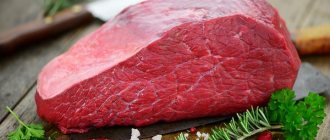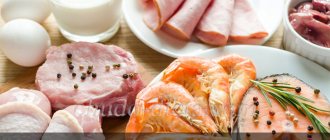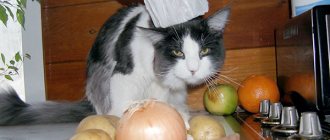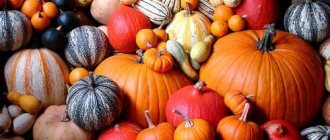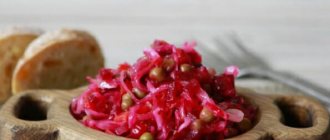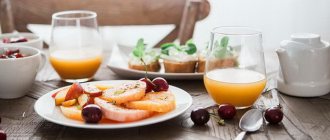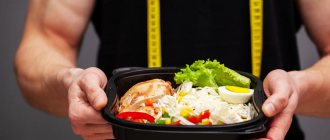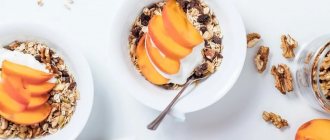A 1200 calorie menu is considered quite strict because the calorie deficit exceeds the norm acceptable for healthy weight loss, equal to 20% of normal food intake. But if you approach the organization of weight loss correctly, then the diet will be varied, and the portions will be voluminous and satisfying, while being absolutely safe for the waist. To create a menu, it is recommended to make sure there are no possible contraindications and use the data of the KBZHU of different products.
- Protein squid salad
1200 calorie menu
A menu with a daily calorie content of 1200 calories can be formed from any products, but it is very important to eat only healthy foods. Depending on your goals, you can choose the most suitable option for a particular person.
KBJU of common products allowed for a diet for losing weight
When losing weight on different nutritional systems, several groups of foods are allowed for consumption, tables indicating the calorie content of which, the content of proteins, carbohydrates and fats (BJU) per 100 grams are given below.
Meat and fish:
| Products | Proteins, g | Fats, g | Carbohydrates, g | Calorie content, kcal |
| Beef stew | 16,8 | 18,3 | 0 | 232 |
| Boiled turkey | 25,3 | 10,4 | 0 | 195 |
| Beef cutlets | 18 | 20 | 0 | 260 |
| Chicken cutlets | 18,2 | 10,4 | 13,8 | 222 |
| Boiled chicken | 25,2 | 7,4 | 0 | 170 |
| Fried chicken | 26 | 12 | 0 | 210 |
| Boiled pork | 22,6 | 31,6 | 0 | 375 |
| Pink salmon in batter | 17,1 | 16,4 | 15,2 | 281 |
| Boiled pink salmon | 22,9 | 7,8 | 0 | 168 |
| Boiled cod | 17,8 | 0,7 | 0 | 78 |
| Fried cod | 23 | 0,1 | 0 | 111 |
| Cod cutlets | 12,6 | 5,9 | 15 | 164 |
Eggs:
| Products | Proteins, g | Fats, g | Carbohydrates, g | Calorie content, kcal |
| Boiled eggs | 12,9 | 11,6 | 0,8 | 160 |
| Fried eggs | 11 | 12 | 0,7 | 180 |
Fermented milk and milk products, cheeses:
| Products | Proteins, g | Fats, g | carbohydrates, g | Calorie content, kcal |
| Brynza | 17,9 | 20,1 | 0 | 252 |
| Yogurt 1.5% | 5 | 1,5 | 3,5 | 47 |
| Low-fat kefir | 3 | 0,1 | 3,8 | 28 |
| Milk | 2,8 | 3,2 | 4,7 | 58 |
| Ryazhenka | 3 | 6 | 4,1 | 82 |
| Cream 10% | 3 | 10 | 4 | 118 |
| Dutch cheese | 27 | 40 | 0 | 468 |
| Russian cheese | 23 | 45 | 0 | 497 |
| Low-fat cottage cheese | 18 | 2 | 1,5 | 96 |
Cereals:
| Products | Proteins, g | Fats, g | Carbohydrates, g | Calorie content, kcal |
| Buckwheat | 12,6 | 2,6 | 68 | 329 |
| Oatmeal | 11,9 | 5,8 | 65,4 | 345 |
| Pearl barley | 9,3 | 1,1 | 73,7 | 324 |
| Millet | 12 | 2,9 | 69,3 | 334 |
| Rice | 7 | 0,6 | 73,7 | 323 |
| Corn | 8,3 | 1,2 | 75 | 325 |
Vegetables:
| Products | Proteins, g | Fats, g | Carbohydrates, g | Calorie content, kcal |
| Eggplant | 0,6 | 0,1 | 5,5 | 25 |
| Green pea | 5 | 0,2 | 13,3 | 75 |
| Green beans | 4 | 0 | 4,3 | 33 |
| Zucchini | 0,6 | 0,3 | 5,7 | 27 |
| White cabbage | 1,8 | 0 | 5,4 | 28 |
| Cauliflower | 2,5 | 0 | 4,9 | 29 |
| Green onion | 1,3 | 0 | 4,3 | 22 |
| Bulb onions | 1,7 | 0 | 9,5 | 44 |
| Carrot | 1,3 | 0,1 | 7 | 34 |
| cucumbers | 0,8 | 0 | 3 | 15 |
| Bell pepper | 1,3 | 0 | 5,7 | 28 |
| Tomatoes | 1 | 0,2 | 3,7 | 20 |
| Radish | 1,2 | 0 | 4,1 | 21 |
| Beet | 1,7 | 0 | 10,8 | 50 |
Fruits and berries:
| Products | Proteins, g | Fats, g | Carbohydrates, g | Calorie content, kcal |
| Cranberry | 0,5 | 0 | 3,8 | 26 |
| Watermelon | 0,7 | 0,2 | 8,8 | 40 |
| Melon | 0,6 | 0 | 9,1 | 39 |
| Lemon | 0,9 | 0,1 | 3 | 33 |
| Grapefruit | 0,7 | 0,2 | 6,5 | 35 |
| Raspberries | 0,8 | 0,3 | 8,3 | 39 |
| Apples | 0,4 | 0,4 | 9,8 | 44 |
| Black currant | 1 | 0,2 | 7,3 | 38 |
| Apricots | 0,9 | 0,1 | 9 | 40 |
| Pears | 0,4 | 0,3 | 9,5 | 42 |
| Plums | 0,8 | 0,2 | 9,6 | 43 |
| Strawberry | 0,8 | 0,4 | 6,3 | 32 |
| Oranges | 0,9 | 0,2 | 8,3 | 38 |
| Cherry | 0,8 | 0,5 | 10,3 | 49 |
| Kiwi | 0,4 | 0,2 | 11,5 | 49 |
Dried fruits:
| Products | Proteins, g | Fats, g | Carbohydrates, g | Calorie content, kcal |
| Dried apricots | 3,39 | 62,64 | 30,89 | 241 |
| Dried apricots | 5 | 67,5 | 18 | 278 |
| Raisin | 2,52 | 78,47 | 16,57 | 296 |
| Dates | 2,45 | 75,03 | 20,53 | 282 |
| Figs | 3,3 | 63,87 | 30 | 249 |
| Dried apples | 3,2 | 68 | 20 | 273 |
Nuts and seeds:
| Products | Proteins, g | Fats, g | Carbohydrates, g | Calorie content, kcal |
| Brazilian nut | 14,3 | 66,4 | 4,8 | 656 |
| Hazelnut | 5 | 61 | 10 | 651 |
| Almond | 18,7 | 57,7 | 13,6 | 645 |
| Walnut | 12 | 61 | 14 | 637 |
| Cashew | 25 | 52 | 12 | 633 |
| sunflower seed | 20,7 | 52,9 | 5 | 578 |
| Pumpkin seeds | 24,5 | 45,8 | 4,7 | 556 |
| Peanut | 3 | 45 | 25 | 551 |
Oils and sauces:
| Products | Proteins, g | Fats, g | Carbohydrates, g | Calorie content, kcal |
| Soy sauce | 2 | 0 | 1 | 12 |
| Ketchup | 2,1 | 0 | 14,9 | 90 |
| Mustard | 9,9 | 12,7 | 5,3 | 143 |
| Olive oil | 0 | 99,8 | 0 | 898 |
| Sunflower oil | 0 | 99,9 | 0 | 899 |
| Butter | 0,4 | 82,5 | 0,8 | 748 |
You can count calories and the content of essential substances using applications that can be easily installed on modern smartphones.
Prohibited Products
When losing weight, you must completely exclude from your diet:
- Sugar and all products that contain it, including sweet drinks, confectionery, store-bought sauces.
- For a menu of 1200 calories, it is better to give up dried fruits and sweet fruits, as well as potatoes - they are high in calories, so their presence in the diet may take up too much of the energy value of the total daily food. The exception is a small amount of raisins and dried apricots in the first half of the day.
- Products made from white flour: rolls, cookies, white bread, pasta.
- Fast food.
- Roast.
- Lard, lard, butter.
- Sausages and canned food containing chemicals.
- Semi-finished products.
- Store-bought snacks with flavor enhancers, colors and flavors.
Balanced diet
An approximate menu for 1200 calories per day for a week of proper nutrition (in this and other examples, the calorie content of a specific amount of product is indicated in parentheses):
| Day | Breakfast | Snack | Dinner | Snack | Dinner | Total daily caloric intake, calories |
| 1 | Porridge from 60 g of dry oat flakes, boiled in water (180) + 100 g of mixed berries (35) = 215 cal | 30 g walnuts = 210 cal | Buckwheat - 40 g raw (150) + steamed chicken cutlet with onions - 200 g (220) + salad of 50 g cucumber, 50 g tomato (10) and 50 g bell pepper (20) = 400 cal | 200 ml low-fat kefir (60) + 100 g orange (35) = 95 cal | 200 g cod cutlets (222) + 100 g cucumber (15) = 237 cal | 1157 |
| 2 | 50 g dry rice, boiled in water (160) + 2 hard-boiled eggs (80) + 100 g nectarine (50) = 270 cal | Sandwich made from 50 g whole grain bread (125) + 30 g avocado (50) + 20 g lightly salted salmon (50) = 225 cal | 100 g of porcini mushrooms stewed in 50 ml of sour cream 10% and water (90) + 200 g of green peas (110) + salad of 100 g of boiled beets (50) with 10 g of walnuts (110), seasoned with 5 ml of olive oil (40 ) = 400 cal | 200 ml low-fat kefir = 60 cal | 100 g boiled shrimp (95) + 150 g baked eggplant (40) + 50 g baked carrots (20), drizzled with 10 ml olive oil (80) = 215 cal | 1170 |
| 3 | Porridge from 60 g of oat bran (170) per 150 ml of milk 0.5% (45) = 215 cal | 100 g cottage cheese 5% (121) + 100 g blueberries (40) = 161 cal | 50 g of raw buckwheat, boiled in water (170) + 150 g of homemade squash caviar made from carrots, zucchini and onions (75) + 100 g of boiled beef (230) = 465 cal | 150 g jelly from milk 0.5% = 70 cal | 120 g baked salmon (260) + salad of 100 g cucumbers (15) and 100 g tomatoes (20) = 295 cal | 1206 |
| 4 | Porridge from 60 g of dry oat flakes, boiled in water (180) + 20 g of sunflower seeds (110) = 290 cal | Salad of 50 g pear (30), 50 g apple (25), 50 g kiwi (30), dressed with 50 ml low-fat yoghurt (30) = 115 cal | Stew of 100 g zucchini (27), 50 g onions (20), 100 g asparagus (20), 50 g carrots (20), 50 g bell pepper (15) = 100 cal + 150 g steamed chicken cutlet (300) = 400 cal | 200 ml kefir (60), 100 g berries (40) = 100 cal | Baked fish in the Russian style - 150 g cod fillet (120) + 100 g boiled potatoes (80) + 50 g onions (20) + 20 g Adyghe cheese (50) = 270 cal | 1175 |
| 5 | Porridge from 60 g of dry buckwheat, boiled in water (180) + 2 eggs (100) + 100 g of cucumbers (15) = 295 cal | 150 g cottage cheese casserole (120) + 100 g strawberries (32) = 152 cal | Cheese soup made from 100 g broccoli (35), 100 g cauliflower (25), 50 g carrots (20) and 80 g cheese 45% (320) = 400 cal | 200 ml low-fat yogurt (60) + 10 g dry fiber (20) = 80 cal | 200 g cutlets from 130 g cod (100), eggs (50) and 20 g onions (10) + 150 g cabbage salad (42), dressed with 5 ml olive oil (50) = 252 cal | 1179 |
| 6 | Oatmeal pancake from 60 g dry oat flakes (180), eggs (50), 100 ml milk 0.5% (30) = 260 cal | Apple 150 g (75), baked with 50 g cottage cheese 5% (60) = 135 cal | Vegetable vinaigrette from 100 g beets (50), 50 g onions (20), 100 g carrots (35), 100 g white boiled beans (123), 100 g fresh cucumber (15), 20 g herbs (12), 10 ml olive oil (90) = 345 cal | 200 g orange (76) cal + 10 g walnut (70) = 136 cal | 200 g boiled cod (160) + salad of 100 g tomatoes (20), 100 g cucumbers (15), 50 g bell pepper (20), 10 g olives (50) = 265 cal | 1141 |
| 7 | Lazy oatmeal from 60 g oat flakes (180) + 100 g mixed berries (40) + 100 ml 0% yoghurt (30) = 250 cal | Sandwich made from 50 g whole grain bread (125) + 30 g hard cheese 45% (11 0) = 235 cal | 200 g cabbage (80), stewed with 50 g onions (20), 50 g carrots (17), 150 g steam chicken cutlet with onions added to the minced meat (280) = 397 cal | 200 ml low-fat kefir (60) + 100 g kiwi (60) = 120 cal | 150 g boiled squid (165) + 150 g cabbage salad (42) = 207 cal | 1209 |
This menu with accurate calorie counting can be used as a basis for proper nutrition (PN) for a month or a longer period of time, adjusting it to suit your own tastes, but controlling the number of calories.
Benefits of PP for weight loss:
- with a balanced diet, the body receives all the necessary substances for the full functioning of all organs;
- a variety of products allows you to reduce the likelihood of breakdowns and make it easier to lose weight;
- the selection of products can be individual, the main thing is to take into account the calorie content and follow the principle “for dinner - proteins + vegetables”;
- experts say that losing weight while following such a diet is considered as safe as possible for health and maintaining an attractive appearance;
- There is no need to go out of the diet in any special way; it is enough to increase the caloric intake by 200-300 calories every week.
There are no disadvantages to a proper balanced diet, but undisciplined people may find it difficult to organize it at the initial stage of losing weight.
Protein diet
A protein diet is often used for quick and effective fat burning, because with an abundance of protein foods in the menu and a reduction in carbohydrates, the energy to maintain vital functions is drawn from adipose tissue.
The optimal daily distribution of proteins, fats and carbohydrates for an ordinary person (not a professional athlete) who wants to get rid of body fat is considered to be: 60% proteins, 30% carbohydrates, 10% healthy fats.
Example of a weekly menu for protein diets:
| Day | Breakfast | Snack | Dinner | Snack | Dinner | Total daily caloric intake, calories |
| 1 | Cheesecakes from 150 g of cottage cheese 5% (182), 1 egg (25), 20 g of corn starch (80) + 100 g of berries (40) = 327 cal | Jelly from 200 ml milk 0.5% (60), 20 g gelatin (18), sweetener, 100 g orange (35) = 113 cal | 200 g boiled chicken fillet (280), 100 g baked eggplant (25), poured with 5 ml olive oil (50) = 375 cal | 2 hard-boiled eggs (60), 100 g tomato (20) = 80 cal | 150 g baked salmon (300), 100 g cucumber (15) = 315 cal | 1210 |
| 2 | Omelette of 2 eggs (100), 100 ml low-fat milk (60) with 50 g bell pepper (20) and 100 g tomato (20) = 200 cal | Curd mousse from 150 g cottage cheese 0% (105), 10 g cocoa (23), 10 g gelatin (9), 100 g strawberries (33) = 171 cal | 150 g boiled beef (375) + salad of 100 g cucumbers (15) + 50 g tomatoes (10) + 100 g white cabbage (28) = 428 cal | 200 ml kefir 0% (60) + 10 g dry Siberian fiber (4) = 64 cal | 200 g boiled shrimp (180) + 100 g green peas (55) + 100 g white cabbage salad, dressed with 5 ml olive oil (70) = 300 cal | 1173 |
| 3 | Oatmeal pancake from 60 g oatmeal (180), eggs (50), 100 ml milk 0.5% (30) with 80 g cottage cheese 0% (60) and 50 g berries (20) = 340 cal | Salad of 100 g orange (60), 50 g kiwi (30), dressed with 50 ml low-fat yoghurt (15) = 105 cal | Soup from 100 g broccoli (34), 100 g cauliflower (25), 100 g green peas (55), 200 g chicken fillet (280), = 394 cal | 200 ml 0% yoghurt (60) + 50 ml beetroot juice (30) = 90 cal | 130 g steamed salmon (260) + hard-boiled egg (25) + 100 g cucumber (15) + 100 g = 300 cal | 1229 |
| 4 | Cottage cheese casserole from 400 0% cottage cheese (280), 2 eggs (100), 80 g oat flour (280), 50 g raisins (160) and sweetener = 710 cal for 4 servings, you can eat 1.5, that is 226 cal | 30 g walnuts (210), 100 g green apple (44) = 244 cal | 200 g boiled turkey (260), 100 g baked zucchini (30), 100 g baked bell pepper (40) = 330 cal | 200 ml kefir 0% (60) + 10 g oat bran (32) = 92 cal | Protein salad of 200 g boiled squid (220), hard-boiled eggs (25), 100 g cucumber (15), seasoned with 20 ml lemon juice (5) = 265 cal | 1157 |
| 5 | 2 egg omelette (100), 100 ml milk 0.5% (30), 100 g green peas (55), 50 g whole grain bread (125) = 400 cal | Cocktail of 200 ml kefir 0% (60) with 100 g of berries (40) = 100 cal | 200 g chicken breast (280), stuffed with 100 g cottage cheese 0% (70), 150 g coleslaw (45) = 395 cal | 200 ml of kefir (60) with cucumber puree (8) and 10 g of greens (6) = 74 cal | 200 g steamed cod fillet (160) + baked vegetables - eggplant 100 g (28), pepper - 100 g (40), sprinkled with 10 ml olive oil (80) = 248 cal | 1217 |
| 6 | Curd mousse made from 200 g of cottage cheese 5% (242), stevia and 15 g of gelatin (9), 10 g of cocoa (23) = 274 cal | Salad from 100 g apple (44), 100 g orange (35) + 100 ml 0% yoghurt (30) = 109 cal | 150 g boiled beef (375), 200 g boiled beet salad (100) = 475 cal | 200 ml low-fat kefir (60) + 10 g oat bran (32) = 92 cal | 200 g boiled squid (220) + 200 g cucumbers (30) = 250 cal | 1200 |
| 7 | Lazy oatmeal from 60 g oat flakes (180) + 100 g mixed berries (40) + 100 ml 0% yoghurt (30) = 250 cal | 100 g kiwi (60), 200 ml 0% yoghurt (60) = 120 cal | 200 g stewed chicken meatballs (280) + 100 g coleslaw (40), dressed with 5 ml olive oil (4 5) = 365 cal | 100 g cottage cheese 0% (70) + 30 g any greens (20) = 90 cal | Canned tuna salad 150 g in its own juice (150), 2 hard-boiled eggs (50), 100 g cucumber (15) + 10 ml sesame oil (90) = 280 cal | 1105 |
Benefits of protein nutrition:
- quick results;
- adipose tissue disappears, but muscle tissue remains;
- proteins take a long time to digest and provide a feeling of fullness for a long time;
- Despite a fairly large number of restrictions, the menu can be varied and tasty.
Disadvantages of a low-calorie protein diet:
- many contraindications for health reasons;
- difficult to tolerate by people accustomed to eating large amounts of carbohydrates, so breakdowns in carbohydrate products are possible;
- you need to exit it correctly in order to maintain the result: expand the menu with new products and gradually increase calorie content;
- Side effects may occur in the form of dizziness, nausea, constipation.
Fractional meals
The essence of fractional nutrition is to eat a small amount of food by the hour at the same time at least 6 times a day and with an interval of no more than 2.5 hours. The last meal should be 2-3 hours before bedtime. Benefits of this way to lose weight:
- Thanks to frequent meals, it is easier not to feel hungry;
- products do not have to be dietary; sometimes a small amount of unhealthy high-calorie food is allowed;
- small portions will help reduce the size of the stomach and improve the functioning of the digestive system;
- You can stick to this diet for the rest of your life, controlling your caloric intake;
- if you don’t have the desire or skills to cook, then you can eat simple foods with minimal use of heat treatment.
The disadvantage of fractional nutrition is the difficulty of organizing it; in all other respects, it is flexible and allows you to adjust it to suit any purpose.
An example of a menu for a week indicating meals by hour:
| Day | Breakfast - 8:00 | Snack - 10:30 | Lunch - 13:00 | Snack - 15:00 | Dinner - 17:30 | Second dinner - 20:00 | Total daily caloric intake, calories |
| 1 | 60 g oatmeal (180) boiled in water + 100 g apple (40) + 10 g dark chocolate 75% (55), 40 g whole grain bread (125) = 400 cal | 100 g orange (35) + 10 g walnuts (70) = 105 cal | 200 g baked chicken fillet (280) + 100 g grated carrots (34) = 314 cal | 200 ml low-fat yoghurt (60) + 100 g strawberries (33) = 93 cal | 200 g boiled cod (160), 100 g cucumber (15) = 185 cal | Cocktail 100 g low-fat cottage cheese (70) + 100 ml (30) = 100 cal | 1197 |
| 2 | 60 g dry rice, boiled in water (180) + 50 g raisins (160) + 100 g kiwi (60) = 400 cal | Smoothie made from 200 g berries (80) + 10 g chia seeds (50) = 130 cal | 150 g boiled beef (380) + 100 g cabbage salad (40) = 420 cal | 200 ml Lassi drink = 70 cal | 150 g squid (165) + 100 g cucumber (15) = 180 cal | 200 ml kefir 0% = 60 cal | 1240 |
| 3 | 60 g dry buckwheat (180), boiled in water, 2 hard-boiled eggs (50), 40 g whole grain bread (125) = 355 cal | Pudding made from 100 ml kefir (30), 100 g peach pulp (40) and 10 g chia seeds (48) = 118 cal | 60 g dry rice (180), cooked in water, 100 g green peas (55), 100 g baked chicken breast (140) = 375 cal | 200 g applesauce = 88cal | 150 g boiled chicken breast (210) + 100 g tomatoes (20) = 230 cal | 200 ml low-fat yogurt = 60 cal | 1226 |
| 4 | Pancakes made from 50 g rice flour (180), eggs (25), 80 ml milk 0.5% (25), sweetener and 2 g baking powder (16) = 246 cal | Salad of 100 g kiwi (60), 100 g orange (35) and 10 g sunflower seeds (58) = 153 cal | 200 g boiled turkey fillet (260), stewed cabbage - 200 g raw (56) with 50 g carrots (17) = 334 cal | 200 ml Lassi drink, 20 g walnuts (140) = 210 cal | 200 g boiled hake (190), 100 g cucumbers (15) = 205 cal | 200 ml low-fat kefir (60) + 5 g cinnamon (12) = 72 cal | 1220 |
| 5 | Curd mousse made from 200 g of cottage cheese 5% (242), stevia and 15 g of gelatin (9), 10 g of cocoa (23) = 274 cal | Energy bar of 50 g raisins (150), 20 g rolled oats (36), 10 g walnuts (70) = 256 cal | Vegetable vinaigrette from 100 g beets (50), 50 g onions (20), 50 g carrots (17), 50 g white boiled beans (60), 100 g fresh cucumber (15), 20 g herbs (12), 10 ml olive oil (90) = 264 cal | 200 ml kefir 0% = 60 cal | 150 g baked salmon (300), 100 g tomatoes (20) = 320 cal | 100 g cottage cheese 0% (70) + 10 g Siberian fiber (4) = 74 cal | 1248 |
| 6 | 2 egg omelette (50), 100 ml milk 0.5% (30), 100 g green peas (55), 40 g whole grain bread (125) = 260 cal | 100 g applesauce = 88 cal | 200 g boiled chicken breast (280) + 100 g boiled beet salad (50), seasoned with 5 ml olive or sesame oil (50) = 380 cal | 200 g grated carrots (68), seasoned with 5 ml olive oil (45) = 113 cal | 200 g boiled shrimp (180) + salad of 100 g Chinese cabbage (12), 40 g Adyghe cheese (100) = 292 cal | Cocktail of 100 ml milk 0.5% (30) and 100 ml kefir 0% (30) = 60 cal | 1193 |
| 7 | Pancakes made from 50 g oat flour (180), eggs (25), 50 ml milk 0.5% (15), 2 g baking powder (16), sweetener = 246 cal | 200 g orange (70) + 20 g walnuts (140) = 210 cal | Meatballs from 60 g brown rice (180), 100 g chicken fillet (140), 50 g carrots (17) and 50 g onions (20), stewed in water = 357 cal | 2 hard-boiled eggs (50) + 100 g tomatoes (20) = 70 cal | Salad of 150 g squid (165), 100 g cucumber (15) and 2 hard-boiled eggs (50) = 230 cal | 200 ml kefir 0% = 60 cal | 1173 |
Indian menu option
The Indian menu is considered the diet of long-livers - according to statistics, it is in this country that life expectancy is considered one of the highest. The basic principles of this power system:
- Meals should correspond to the cycle of the Sun - by 10 am a light breakfast, from 12 to 14 - a hearty lunch and a light dinner no later than sunset (18:00 in winter and 20:00 in summer).
- You can have breakfast with raw vegetables, fruits, unleavened baked goods, sweets, nuts, and tea in limited quantities.
- You need to dine on vegetable soups, eat legumes, vegetables, fruits, and proper baked goods. The daily meal should be voluminous and satisfying.
- You need to have a light dinner - protein dairy products: cottage cheese, yogurt, kefir, cheese with fruits or vegetables.
- Meat and fish should be avoided completely.
- Finish each meal with Indian spices: curry, cinnamon. This helps freshen breath and improve digestion.
The results that can be achieved on the Indian diet are not only weight loss, but also good detoxification of the body, which will be useful for every person with any health condition.
Sample menu for the week:
| Day | Breakfast | Dinner | Dinner | Total daily caloric intake, calories |
| 1 | Lassi drink – 200 ml (70) + 20 g walnuts (140) + 100 g berries (40) = 250 cal | Soup from 100 g dry white beans (265), 100 g tomatoes (20) and 50 g carrots (17) + 60 g dry brown rice, boiled in water (180), 40 g whole grain bread (125), after an hour – 100 g strawberries (33) = 640 cal | 150 g of Adyghe cheese (180) + 200 ml of kefir 0% (60) + 100 g of watermelon (27) = 267 cal | 1157 |
| 2 | Lassi drink – 200 ml (70) + 20 g sunflower seeds (118) + 100 g kiwi (60) = 248 cal | Soup puree from 100 g of dry peas (298), 50 g of carrots (17) and 100 g of broccoli (34), 60 g of dry bulgur, boiled in water (180) + 100 g of cucumber (15), after an hour - 50 g raisins (150) = 694 cal | Salad of 100 g Chinese cabbage (12), 50 g hard cheese (180), 100 g cucumber (15), dressed with 5 ml olive oil (45) = 252 cal | 1194 |
| 3 | Lassi drink (70) + 100 g of Armenian yeast-free lavash (236) = 306 cal | Puree soup from 100 g lentils (116), 100 g potatoes (80), 50 g onions (20), 50 g whole grain bread (140), 200 g baked eggplants, seasoned with 10 ml olive oil (150), after an hour - 200 g strawberries (70) = 576 cal | Cocktail of 150 g cottage cheese 5% (180) + 100 ml yogurt 0% (30) + 100 g kiwi (60) = 270 cal | 1152 |
| 4 | Lassi drink - 200 ml (70) + salad of 100 g banana (89), 100 g kiwi (60) and 100 g orange (35) = 254 cal | Vegetable vinaigrette from 100 g beets (50), 50 g onions (20), 100 g carrots (35), 100 g white boiled beans (123), 100 g fresh cucumber (15), 20 g herbs (12), 10 ml olive oil (90) + 60 g dry rice, cooked in water (180) + 40 g whole grain bread (125) = 650 cal | 200 g cottage cheese 5% (242) + 100 g strawberries (33) = 275 cal | 1179 |
| 5 | Lassi drink – 200 ml (70), 20 g walnuts (140), 100 g apple (40) = 250 cal | Vegetable stew from 100 g of potatoes (80), 100 g of dry white beans (265), 100 g of bell pepper (40), 100 g of eggplant (28), stewed in water, 50 g of Armenian lavash (118), after an hour - 100 g apples (40) = 571 cal | 200 g cottage cheese 5% (242) + 20 g walnuts (140) = 382 cal | 1203 |
| 6 | 100 g Armenian lavash (236) + 100 g cottage cheese 0% (70) = 306 cal | 100 g dry lentils (116), boiled in water + salad of 100 g boiled beets (50) with 30 g prunes (75) and 10 g walnuts (70), seasoned with 10 ml olive oil (90) + 40 g whole grain bread (125), after an hour - 100 g kiwi (60) = 586 cal | 200 ml kefir 0% (60) + 100 g watermelon (30), 150 g Adyghe cheese (180) = 270 cal | 1162 |
| 7 | 200 g cottage cheese 0% (140) + 20 g walnuts (140) = 280 cal | Soup from 100 g cauliflower (25), 100 g dry white beans (265), 100 g potatoes (80) and 50 g onions (20) + 100 g Armenian lavash (236) = 626 cal | Cocktail of 10 g of cottage cheese 5% (121) + 100 ml of milk 2.6% (53) and 10 ml of kefir 0% (30) + 100 g of berries (40) = 244 cal | 1150 |
The missing calories can be supplemented with spices, chewing which should be completed at the end of each meal, following the Indian method.
The most important thing about calories
Losing weight doesn't have to be difficult. Clients can become slimmer and healthier without having to follow a prescribed meal plan, forcing themselves to exercise, or even counting calories.
This doesn't mean it will be easy. Fat loss, like any change in life, often requires trying new things, getting out of your comfort zone and changing old habits to new ones. And when it comes to food portions, size matters. But customers don't need a calculator, scale, or calorie-counting app.
All they need is their hand. And the desire to try something new.
How to adapt this approach to nutrition?
If clients are very active, want to gain weight, or just have a larger physique, you may want to advise them to add a handful of carbohydrates or a thumb of fat to several meals a day.
Conversely, if clients are inactive, looking to lose weight, or have a modest build, you may need to encourage them to remove a handful of carbohydrates or a thumb of fat from several meals a day.
Finally, evaluate your clients' results. If they achieve their goals, let them continue as before. If not, then select the required number of servings.
What about more advanced clients?
Overall, this system works surprisingly well for most clients. In our experience, it meets the needs of 75–85% of training people.
However, clients with specific or advanced goals, such as bodybuilders or high-level athletes, often require more detail and complexity. These people usually effectively use the proposed system in the off-season. And as competition approaches, they require adjustments - adjusting based on body type, consuming carbohydrates and calories in cycles, following a specific nutrition plan, and so on.
Source:
Tips for choosing the right menu
Tips from nutritionists on how to choose the most suitable menu for weight loss:
- Consider the goal. If there is no need to lose weight urgently, then you need to give preference to proper nutrition. If an important event is coming up soon, you can start with a protein diet and move from it to proper nutrition. At the same time, the frequency of meals can be borrowed from fractional meals, and the abundance of vegetables and fruits from the Indian menu.
- Take into account taste preferences. If a person likes to eat meat and fish, then a protein diet is suitable for him; if for some reason he does not eat animal proteins, he can lose weight on a fractional diet with plant foods or the Indian food system.
- Coordinate the diet with the state of health - if there are contraindications to any products that are basic in a particular weight loss system, you need to consider another option.
- Take into account physiological characteristics. Thus, experts say that those with an “Apple” body type lose weight better on plant-based foods; for “Pears,” any of the listed menu options is suitable, but with strict calorie counting; “Hourglass” figures and those with a very distended stomach are ideal fractional meals are suitable, for the “Inverted Triangle” it is best to lose weight on protein diets, and for “Banana” it is enough to replace animal fats with vegetable ones and not overeat.
There is also a theory that the choice of products for weight loss should be made based on your blood type. For those who have the first - focus on proteins, the second - on vegetables and exclude fatty meats, the third - on all foods in moderation, except dairy, the fourth - eat everything, but in small quantities, as on fractional meals.
The Best Way to Control Portions and Calories
At Precision Nutrition, we use a simple method to help people understand how much they are eating. It is lightweight, portable and adjustable to fit a person's size. All you need is the ability to count to two and your hands.
How it works:
- The palm determines the portion of protein.
- The fist determines the portion of vegetables.
- A handful defines a serving of carbohydrates.
- The thumb determines the portion of fat.
Of course, everyone has differences. This is not the “ideal” way for every situation, nor is it the “ideal diet” for everyone. But since larger people tend to have larger hands and smaller people tend to have smaller hands, your hand can become a personal (and portable) food-measuring device.
Possible contraindications to the diet
A weight loss program using a menu of 1200 kcal per day for a week can be harmful to people’s health in the following cases:
- if 1200 kcal is significantly less than the required daily calorie intake and the calorie deficit is more than 30%, then loss of strength and anemia are possible;
- if a person’s work involves intense physical or mental stress;
- if the patient is undergoing a period of rehabilitation after operations or complex illnesses.
A low-calorie diet is guaranteed to bring results, but those who are losing weight need to keep their condition under control and, in case of weakness, dizziness or poor health, consult a doctor and increase their daily caloric intake.



